
Beyond the aesthetic purposes usually sought by bodybuilders, building strong shoulders and trapezius muscles or traps has several functional applications. These include improved posture, better mobility, and building more efficient movement patterns. Shoulders and traps workouts can also help improve lifting performance and improve cardiovascular health.[1]
In this comprehensive mass-building guide, we’ve looked at barbell shoulder workouts for both muscle groups. We’ve included some unilateral exercises for shoulders and traps to work on muscular imbalances. Alongside this, we’ve added some cardio-based exercises for concurrent exercise options to improve sports performance.[2] The shoulder workout exercises below represent a complete shoulder trap workout for mass building. Most exercises require little equipment and experience to perform and progress.
Best Exercises For Shoulders And Traps
Here are the top eight shoulder and trap exercises for mass building:
- Standing Barbell Overhead Press.
- Trap Bar Shrugs.
- Seated Arnold Press.
- Farmers Carry.
- Kneeling Landmine Press.
- Cable Shrugs.
- Standing Push Press.
- Barbell Rack Pulls.
Each shoulder and upper back exercise has been chosen with a specific goal in mind, making them suitable when paired together. These are the best exercises for traps and shoulders when programmed correctly.
Best Shoulders And Traps Workout Exercises 2024
The eight shoulder and trapezius exercises below offer a range of different movement patterns. They also help to work on muscular imbalances and provide some cardio-based exercise options for different shoulder workouts.
Standing Barbell Overhead Press
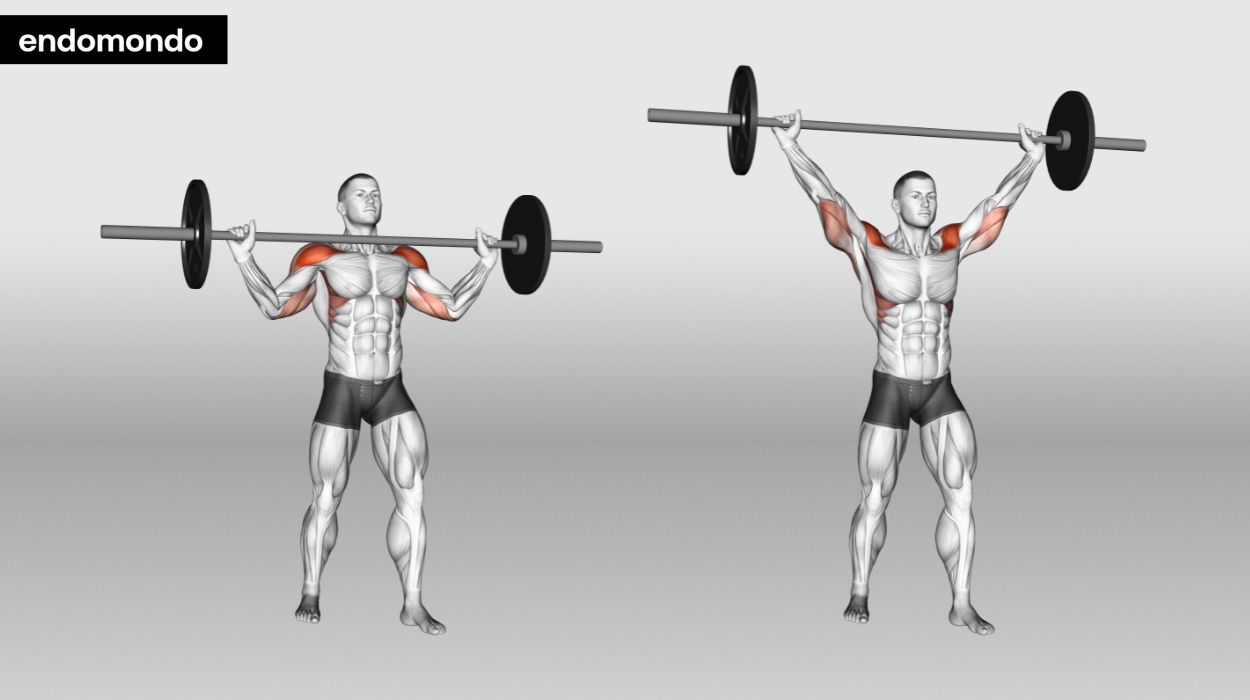
The standing barbell overhead press involves pressing a loaded barbell overhead and bringing it back down under control. It strengthens all three deltoid muscles – the front (anterior), middle (lateral), and back (posterior) heads. This makes it a great compound exercise for shoulders to improve overall shoulder size and strength.
It remains a staple of any high-quality mass-building program as a full-shoulder workout.
The initial learning curve is fairly small, making it a great exercise for beginners and elite-level athletes. This exercise is suitable for those who want to perform it in the gym or as part of a shoulder workout at home.
How to do:
- Set up a suitable barbell rack, placing the J-cups and barbell at just under shoulder height.
- Grip the barbell with an overhand grip, placing your hands shoulder-width apart. Make sure the top of your chest is nearly touching the barbell.
- Stack your forearms and elbows vertically while ensuring the barbell is sitting on the heels of your palms.
- Un rack the barbell and take one step back. Maintain a shoulder-width stance with your head facing forward and chest up. Brace your core and take a deep breath in.
- Press the barbell overhead until your elbows are locked out. Pause briefly with a deep inhale before bringing the barbell back to the starting position under control.
Tips:
- Tilt your head back slightly when pressing to ensure the barbell travels in a straight line.
- Adjust your grip accordingly if your elbows are pointing in or out when gripping the barbell.
- Keep your feet shoulder-width apart throughout the movement.
Optimal Sets And Reps: Three to four sets of 8 to 10 repetitions at a moderate to high rate of perceived exertion.
Standing Trap Bar Shrugs
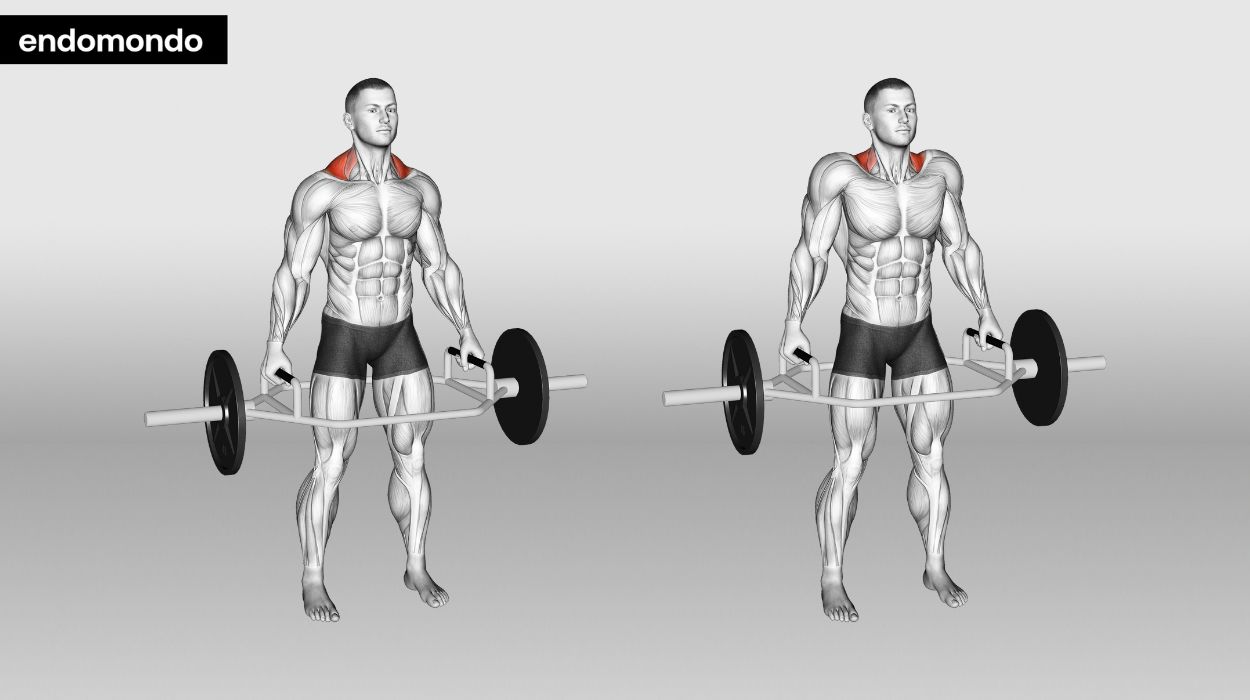
The standing trap bar shrug is one of the best upper body trap exercises that utilizes a trap bar instead of a barbell. Instead of gripping a barbell at the front of your body, you step into a trap bar using a neutral grip and shrug the bar upwards. This limits the amount of stress placed on your anterior shoulders, wrists, and elbows.
The main muscles worked include the trapezius muscle, anterior shoulders, and forearms. These can be a great addition to a variety of trapezius workouts using a simple movement pattern.
How to do:
- Stand in the middle of the trap bar.
- Perform a standard deadlift using a wide grip to pull the trap bar up to the starting position. The trap bar should now be in line with your hips. Make sure to brace your core and inhale before lifting.
- Once in the starting position, shrug your shoulders up and towards your ears. Pause briefly at the top of the movement.
- Lower the trap bar back to the starting position under control and exhale. Pause again briefly before performing the next repetition.
Tips:
- Aim to touch your ears with your shoulders when shrugging the bar up.
- Focus on elevating your shoulders rather than rounding them forward.
Optimal Sets And Reps: Three to four sets of 10 to 12 repetitions at a moderate rating of perceived exertion.
Seated Arnold Press
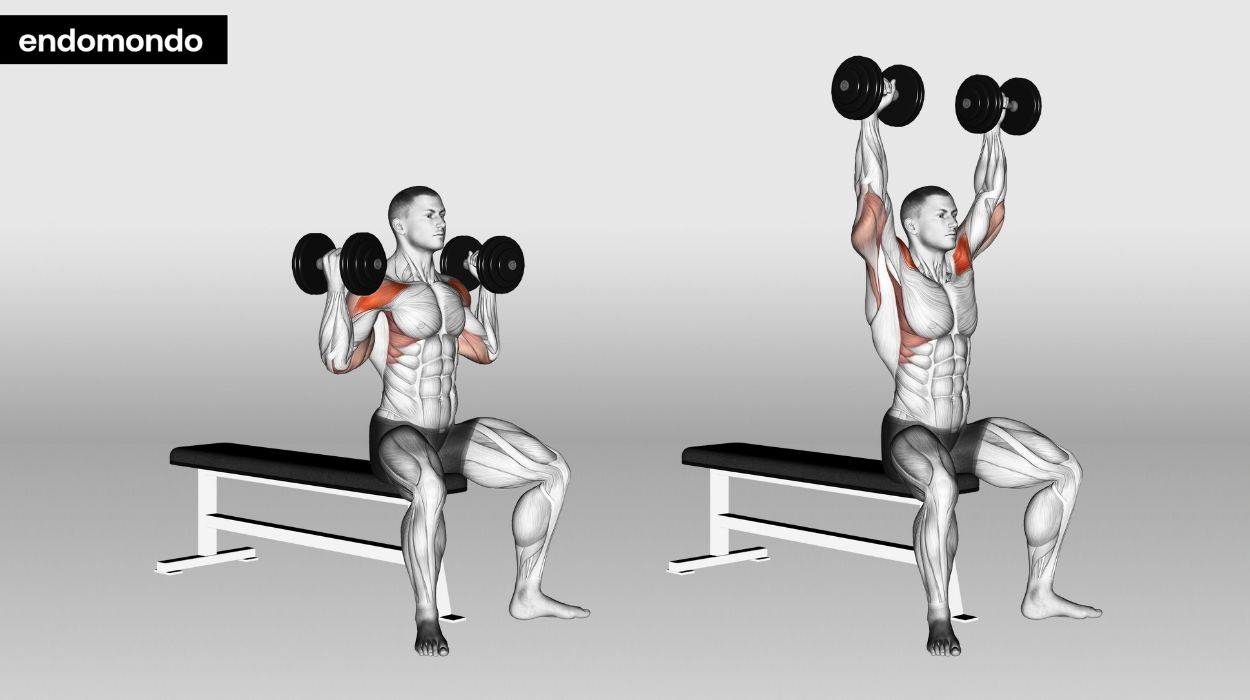
The Arnold Press is a popular shoulder workout with dumbbells invented by the world-famous bodybuilder and actor Arnold Schwarzenegger. It can be used as an alternative to a standard shoulder press.
It involves rotating your arms and hands as you press, increasing the range of motion and time under tension. This leads to more muscular hypertrophy. It engages the anterior, lateral, and posterior deltoid heads. This makes it a great mass builder that can work alongside other rear delt exercises as part of a shoulder and trap workout.
How to do:
- Sit upright on a supported weight bench with the backrest in a vertical position. An unsupported weight bench may also be used.
- Grab a pair of dumbbells and bring them to shoulder height. Your elbows should be tucked in with your palms facing towards you. Inhale before lifting.
- Press the dumbbells up whilst rotating your palms so they are facing away from you. Your elbows should rotate out and back as the dumbbells twist around.
- Bring the dumbbells back down to the starting position by rotating your elbows and palms the opposite way. Exhale as the dumbbells come down. The dumbbells should be back at shoulder height.
Tips:
- Keep your back firmly against the backrest with your chest up and head facing forward.
- Avoid using momentum, engaging your shoulder muscles throughout.
- Ensure your arms are fully extended at the top of the movement whilst keeping your core engaged.
Optimal Sets And Reps: Three sets of 10 to 12 repetitions.
Farmers Carries
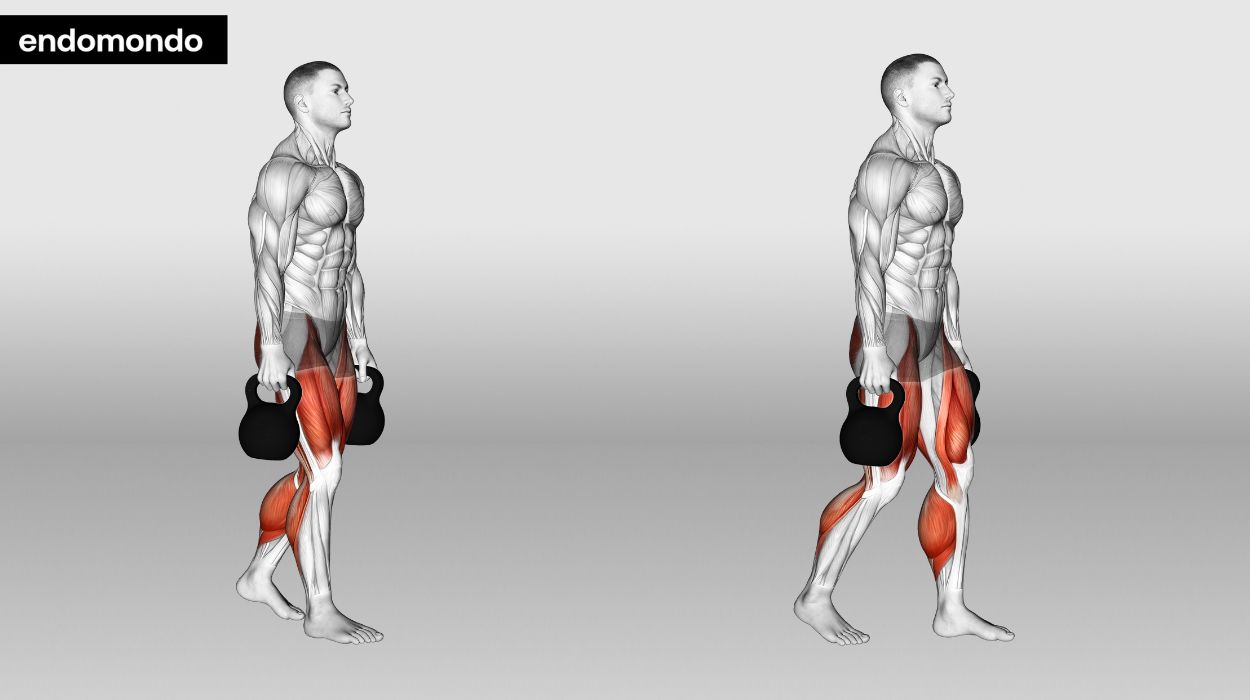
The farmer’s carry is a cardio and strength-based loaded carry variation that involves carrying weights for a set distance. The Farmers Carry is a versatile strength and conditioning exercise that is great for developing core strength and postural control. The trap muscles play a primary role by stabilizing the scapula to keep the shoulders pinned back.
Other muscle groups worked include the shoulders, upper traps, mid traps, forearms, lower back, core, glutes, quads, and calves.
They can be included as part of a shoulder workout using machines and free weights depending on your specific workout goals.
How to do:
- Pick two reference points to establish the distance. Choose weights that allow you to maintain the correct form, as described below.
- With a weight in each hand, take controlled steps forward while following a straight line.
- Keep your chest up and head facing forward throughout. Make sure you engage your core and pull your shoulders back.
- Maintain a steady breathing pattern as you walk.
Tips:
- Allow your shoulders to hang down away from your ears.
- Walk on a padded surface if possible to limit possible joint stress.
- Don’t let the weight pull down too much; use your arm muscles to keep them under control.
Optimal Sets And Reps: Perform three rounds of 20 paces.
Kneeling Landmine Press
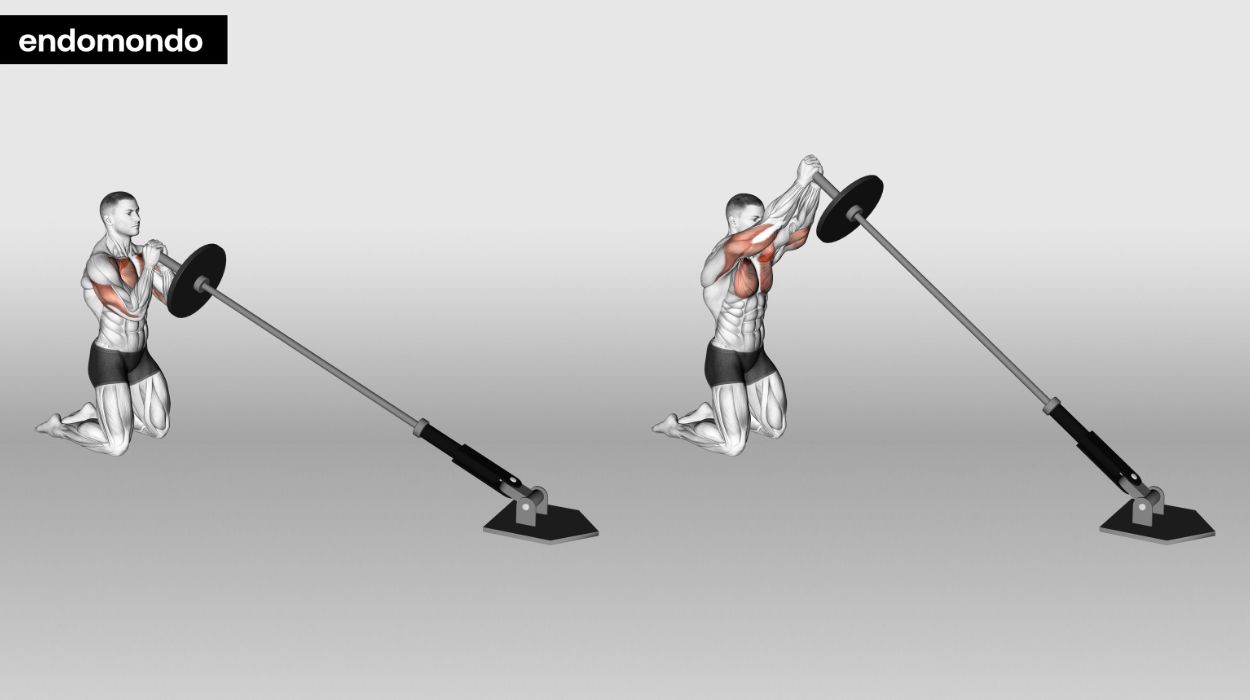
The kneeling landmine press is a unilateral landmine exercise that uses a mixture of vertical and horizontal movements to press a loaded barbell diagonally up. It is a great exercise for shoulders to develop mobility, work on muscular imbalances, and work around an injury. This is primarily due to the stable landmine position.
The main muscle groups worked include the shoulders, triceps, and core musculature.
How to do:
- Assume a half-kneeling position in front of a landmine station. Your left or right knee should be directly in front of your hip, with your ankle underneath your knee.
- Lift the barbell using the hand that’s nearest your back leg. With the barbell at shoulder height, inhale and press the barbell up until your arm is fully extended.
- Exhale whilst bringing the barbell back to the starting position under control.
- Repeat the same movement using the other arm by switching your leg positions.
Tips:
- Keep your core engaged throughout the movement.
- Keep a straight body position and avoid excessive twisting motions.
Optimal Sets And Reps: Perform two to three sets of 12 repetitions on each side.
Cable Shrugs
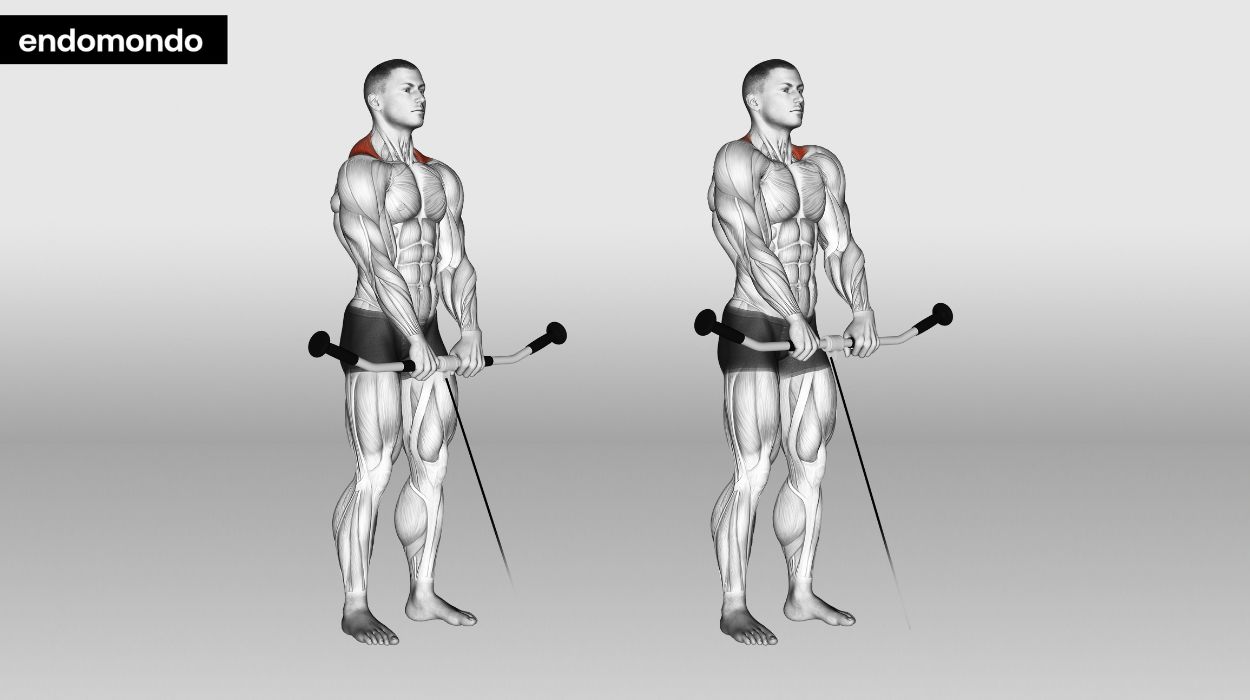
The standing cable shrug is a variation of the traditional barbell shrug that uses a loaded cable machine and rope attachment. Performing shrugs using a cable machine provides constant tension to your traps as you move through the full range of motion. They are one of the best trap exercises that use a cable machine.
Cable shoulder workouts such as the standing cable shrug allow precise loading. This makes them great for higher repetition sets and different training methods such as tempo sets, pause sets, and drop sets. The main muscles worked are upper traps, middle traps, shoulders, and upper back. They can be done as part of a shoulder trapezius workout.
Make sure to exhale during the concentric portion. Inhale during the eccentric portion when bringing the weight down again.
How to do:
- Stand straight in front of the pulley machine, facing forward in proper form and using a normal stance.
- Grip the rope attachment and inhale. Bring the rope towards your hips at the front of your body. Keep your chest up and arms extended.
- Bring your shoulders up toward your ears in a shrug-like movement and pause briefly at the top of the movement.
- Exhale whilst returning to the starting position and repeat.
Tips:
- Avoid using your arms to shrug the weight upwards; instead, use your traps.
- Maintain a controlled tempo throughout each rep.
- Avoid leaning forward and dropping the weight if it feels too heavy.
- Take a deep breath and exhale during the concentric portion when shrugging the weight up. Inhale as you lower the weight back down, and repeat.
Optimal Sets And Reps: Perform three sets of 12 to 15 repetitions.
Standing Barbell Push Press
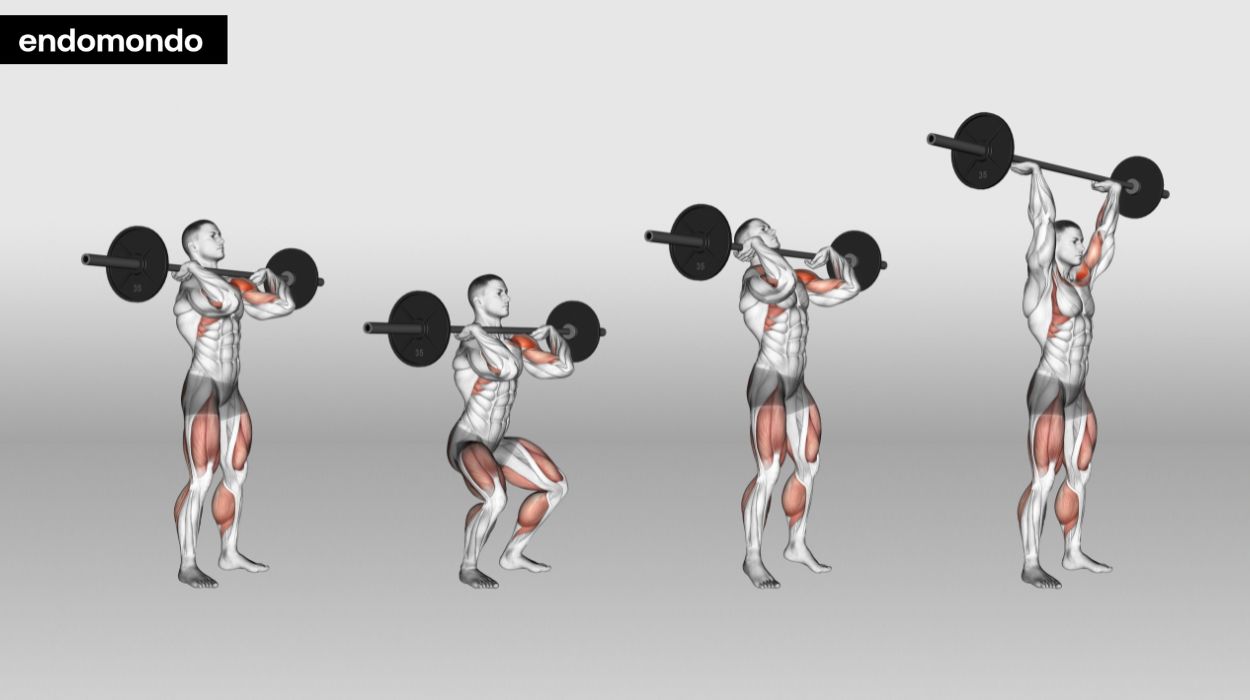
The standing push press uses the same starting position as the barbell overhead press but with a different movement pattern. Instead of maintaining a fixed body position, the push press uses a leg drive and pressing motion to lift the weight overhead. The push press translates well into power-based sporting performance and helps to develop explosive strength.
The main muscles worked include the shoulders, triceps, quads, and core musculature. Different variations can be performed using dumbbells, kettlebells, or barbells.
How to do:
- Using a suitable weight rack, set up a loaded barbell at shoulder height. Use the same setup process as you would for a normal standing overhead barbell press.
- Unrack the barbell and take a step back. Take a deep breath in and prepare to lift. This can also be done without a rack if desired.
- Ensure your hands are just outside your shoulders. Adopt a hip-width stance with your elbows in front of the bar.
- Bend your knees slightly so they go just over your toes. Forcefully push the barbell overhead by using a leg drive whilst pressing the weight up. Your hips and legs should extend as you press.
- Pause briefly at the lockout position. Your hips, knees, and arms should be fully extended. Returning to the starting position under control.
Tips:
- Make sure to use your leg drive alongside your shoulders.
- Push up explosively but maintain control throughout the movement.
- Avoid leaning back too much when pressing upwards during the leg drive.
Optimal Sets And Reps: Five sets of 5 repetitions at a high rating of perceived exertion.
Barbell Rack Pulls
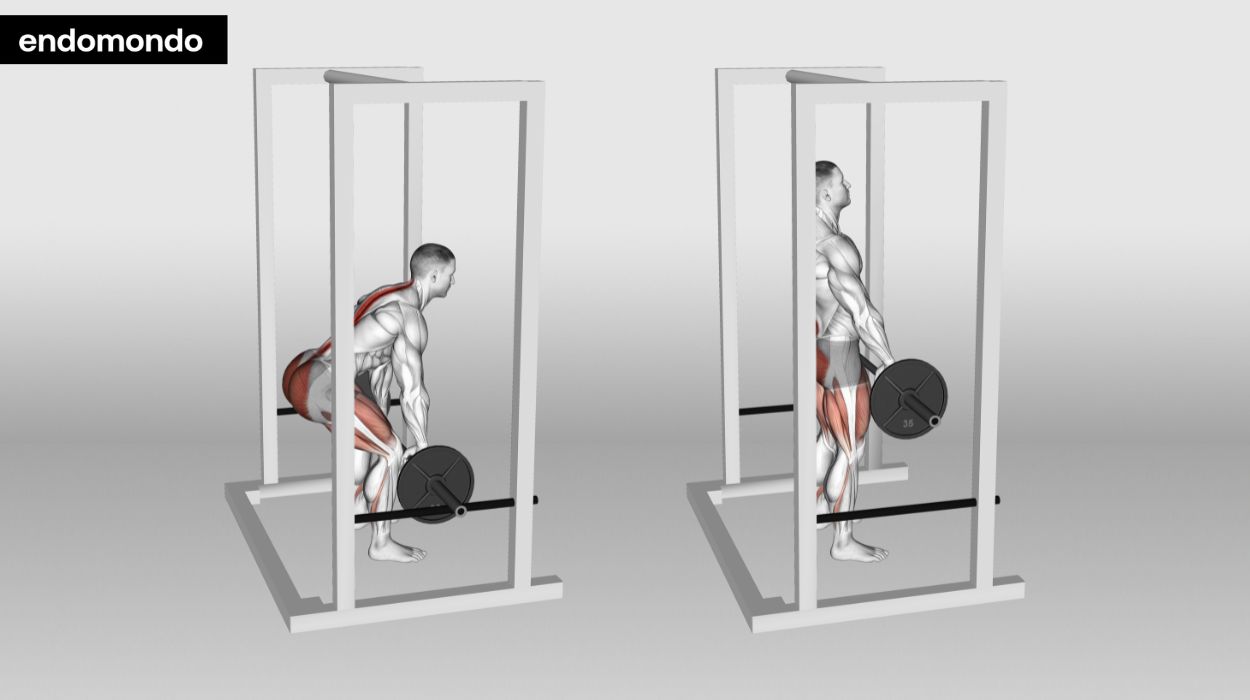
The standing barbell rack pull is a staple among strength and power athletes. It helps to increase pulling and grip strength and improve the lockout portion of the deadlift. The barbell is set up just below or above the knee joints.
Rack pulls work the whole posterior chain. This includes the upper and middle traps, mid back, lats, forearms, quads, glutes, hip flexors, hamstrings, and calves. They are a serious mass-building exercise to develop strength and power. They can be programmed as part of a shoulder and trap workout or alongside dumbbell back exercises.
How to do:
- Set up a loaded barbell inside a power rack at just below or just above knee height.
- Stand in front of the bar and hinge at the hips whilst keeping a neutral back position. Make sure your knees are slightly bent with your glutes pushed out.
- Grab the barbell using a shoulder-width grip position.
- Brace your core and bring your shoulders back. Drive your feet into the ground. stand up and thrust your hips forward, allowing the barbell to pass your knees.
- Once your knees are locked out, pause briefly and return to the starting position under control.
Tips:
- Avoid excessive back rounding to limit the stress placed on your lower back.
- When going heavy, use a weightlifting belt and lifting straps as required.
Anatomy Of Trap Muscles
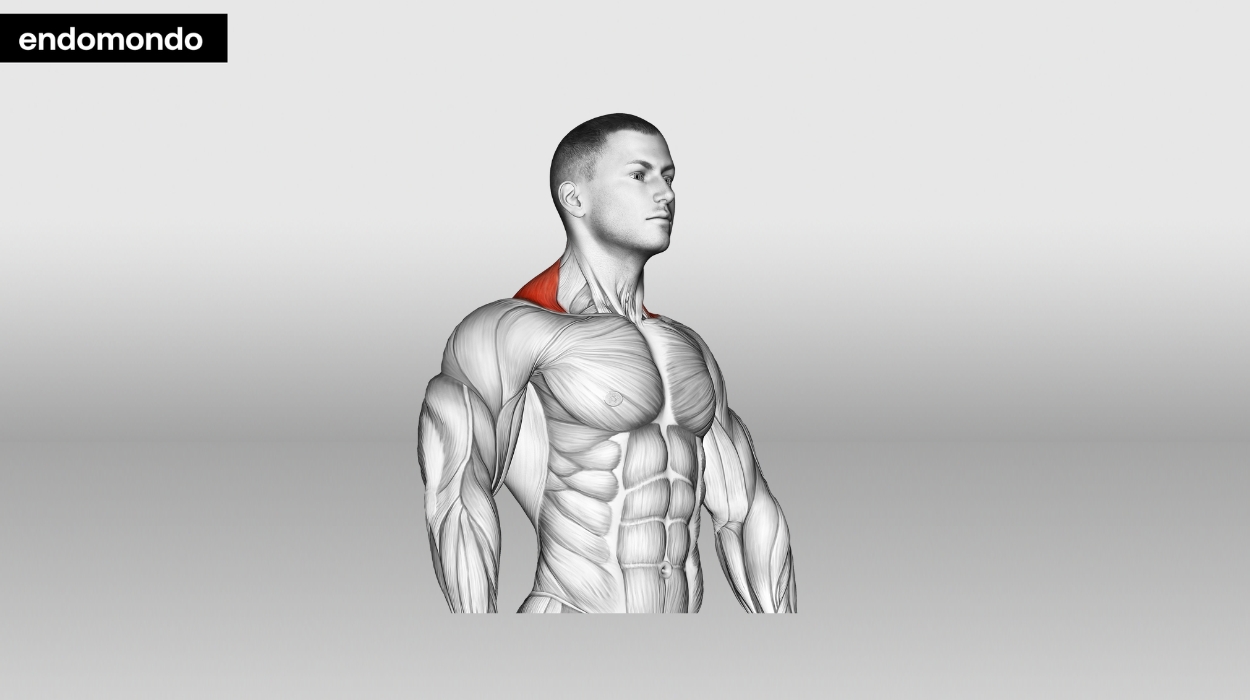
The trapezius muscle is a large, superficial muscle that sits on both sides of the upper back. Whilst it is classed as one muscle, it’s usually referred to as three parts – the upper, middle, and lower portions. It originates from the cervical spine and the 12 thoracic vertebrae.
The trap muscles have three main functions:
- Scapula Retraction – Pinching both shoulder blades together.
- Scapula Depression and Elevation – Lifting and dropping the shoulders.
- Scapula Outward Rotation – Lifting the arms out to the sides of the body.
The trapezius muscle plays a leading role in shoulder health function both in and out of the gym. Weak traps may lead to poor overhead mobility. This then forces other muscles to compensate. This may negatively impact gym performance and increase the risk of injury in compound lifts such as the deadlift and bench press.
Benefits Of Shoulders And Traps Workouts
Building strong shoulders and traps by performing regular workouts for shoulders and traps has several functional and performance-based benefits. These involve the whole body and translate into daily life. We’ve listed the main ones below:
Better Overhead Mobility
The shoulder is a ball and socket joint which is one of the most mobile joint types in the human body. When performing shoulder flexion during overhead movements, the shoulder joint should be able to move 180 degrees overhead. The scapula stabilizers along with the rotator cuffs, are crucial to maintaining proper shoulder mobility.
Performing regular shoulder and trap workouts helps to develop better overhead mobility[3] by allowing the shoulder stabilizer muscles and rotator cuffs to function normally.
Improved Posture
Performing regular shoulder and trapezius workouts improves your posture. They do this by enhancing your sense of proprioception when sitting or looking down for long periods. Having strong shoulders and traps helps to keep your shoulders from rounding[4] by pinning your shoulder blades back. Your traps also function to tilt your head up and down and stabilize your scapula. This can help to reduce shoulder pain due to incorrect posture.
Improved Pulling Performance
The traps help to retract your shoulder blades[5] and prevent your upper back from rounding when pulling. Alongside this, better shoulder mobility helps to stabilize the weight overhead. Stronger shoulders and trap muscles lead to better pulling performance.
Aesthetics
Regularly performing well-programmed shoulder and trap workouts will help to develop fullness at the sides and back of the shoulders. If you want to develop a good V-taper, having strong shoulders with strong middle and lower traps will undoubtedly help to achieve this.
Conclusion
The shoulders and traps play significant roles in maintaining correct posture, performing efficient movement patterns, and in certain aspects of sports performance. The shoulder exercises above provide the best shoulder workouts programmed effectively. The trapezius exercises are some of the best trap workouts that can be performed with the shoulders or on their own.
Use the exercise guidance and follow the workout tips to perform them safely.
Frequently Asked Questions
You can train your shoulders and traps together but bare in mind that most shoulder training will also target the upper trap muscles. Manage volume appropriately to avoid overtraining.
The traps are a key upper back muscle group that assists in pulling and shoulder stability. While it makes the most sense to work them alongside the shoulders, they can also be performed with the back or split between the two.
Out of all the major muscle groups, hitting your traps on shoulder day would be the preferred option due to most shoulder exercises also involving them. However, most back-based rowing exercises will also contribute to mid-trap development when performed correctly.
While the trap muscles tend to recover quicker than other muscle groups, they need time to grow and recover.
Because the traps are involved in most movements to a certain degree, look to specifically target them one to two times each week.
Generally speaking, the trapezius muscles tend to recover quickly, allowing you to train them more than once weekly if desired. If the majority of your training focuses on heavy compound training, specifically targeting your traps once a week is likely enough.
Resources
- Schroeder, E.C., Franke, W.D., Sharp, R.L. and Lee, D. (2019). Comparative effectiveness of aerobic, resistance, and combined training on cardiovascular disease risk factors: A randomized controlled trial. PLOS ONE, [online] 14(1), pp.e0210292–e0210292. doi:https://doi.org/10.1371/journal.pone.0210292.
- Gillen, Z.M., Wyatt, F.B., Winchester, J.B., Smith, D.A. and Ghetia, V. (2016). The Relationship Between Aerobic and Anaerobic Performance in Recreational Runners. International journal of exercise science, [online] 9(5), pp.625–634. Available at: https://www.ncbi.nlm.nih.gov/pmc/articles/PMC5154721/#:~:text=Research%20has%20indicated%20that%20combined,between%20aerobic%20and%20anaerobic%20performance.
- Plummer, H.A., Plosser, S.M., Diaz, P.R., Lobb, N.J. and Michener, L.A. (2022). Effectiveness of a Shoulder Exercise Program in Division I Collegiate Baseball Players During the Fall Season. The International journal of sports physical therapy, [online] 17(2). doi:https://doi.org/10.26603/001c.31638.
- Hasan, S., Iqbal, A., Alghadir, A., Asma Alonazi and Danah Alyahya (2023). The Combined Effect of the Trapezius Muscle Strengthening and Pectoralis Minor Muscle Stretching on Correcting the Rounded Shoulder Posture and Shoulder Flexion Range of Motion among Young Saudi Females: A Randomized Comparative Study. Healthcare, [online] 11(4), pp.500–500. doi:https://doi.org/10.3390/healthcare11040500.
- Camargo, P.R. and Neumann, D.A. (2019). Kinesiologic considerations for targeting activation of scapulothoracic muscles – part 2: trapezius. Brazilian Journal of Physical Therapy, [online] 23(6), pp.467–475. doi:https://doi.org/10.1016/j.bjpt.2019.01.011.




